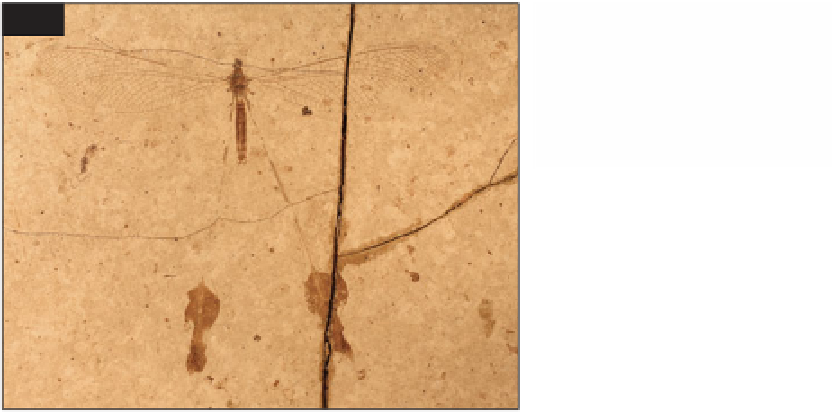Geoscience Reference
In-Depth Information
V-shape, like a tent. Snakeflies are so-called
because their long neck makes their head
resemble that of a snake. Several species are
known from Florissant. In spite of their
having aquatic larvae, there are no
megalopteran fossils known from Florissant.
Among the fossil lacewings at Florissant,
however, is a beautiful specimen of a thread-
winged lacewing,
Marquettia americana
(
238
), which belongs to a family that no
longer occurs in North America.
Beetles (Coleoptera) are the most
diverse of all animals today, comprising
some 25% of all living species and 40% of
all insects. They are easily recognized by
their forewings, which are hardened into
tough cases (elytra) that protect the
delicate, membranous hindwings folded
beneath the elytra when not in use. The
hard elytra have high preservational
potential, so it is not surprising that
beetles account for 38% of the insects
known from Florissant, with some 600
species! About 10% of beetles belong in
the suborder Adephaga, a group of mainly
predatory forms. Most of these form the
Geadephaga, mainly the family Carabidae:
the ground beetles, of which many occur
at Florissant. The remainder, the
Hydradephaga, mostly fall into the water
beetle families Dytiscidae (diving beetles)
and Gyrinidae (whirligig beetles). Only
the former occur in Florissant; though
capable of flight, they would have spent
most of their time in the lake.
Nearly all other beetles fall into the
suborder Polyphaga. The staphylinids, or
rove beetles, are characterized by having
short elytra beyond which the long,
flexible abdomen extends. These fast
running ground beetles are represented
by a few dozen species at Florissant (
239
).
The scarabs, dung beetles, and horned
beetles (Scarabaeidae) are represented at
Florissant by a couple of dozen species.
These beetles are adapted for burrowing,
and the males often show sexual
dimorphism with prominent horns.
Buprestids are well known for the
dramatic metallic coloration that gives
them the common name of jewel
beetles. Several species occur at
Florissant, but do not show the beautiful
coloration (which does occur at the
European Miocene site of Grube Messel;
Selden and Nudds, 2004, Chapter 12).
Their larvae burrow into wood. A great
many click beetles (Elateridae) are found
in Florissant. The adults have an
ingenious method of escaping from
predators by jumping using a spring-
loaded mechanism. The larvae live in
rotten wood. Several species of soldier
beetles (Cantharidae) are known from
238
238 The beautiful thread-winged
lacewing Marquettia americana
Neuroptera: Nemopteridae; this
family occurs only in the tropics
and subtropics today NHM.
Wingspan 60 mm 2.4 in.




Search WWH ::

Custom Search